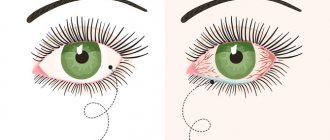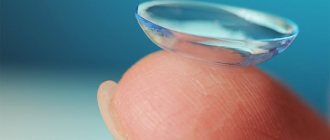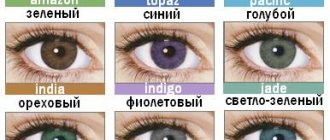What kind of allergy to lenses is this?
An allergy to lenses can hardly be called such in our usual understanding. Yes, many lens wearers suffer from red eyes, but this is certainly not an allergy. After all, if the “contacts” are made of high-quality material, and the wearing period is fully respected, then they are unlikely to cause allergies. Often (if we are talking about the first month of wearing) this is just a normal reaction to a foreign irritant, which passes quickly enough, or a seasonal allergy. Also, some components of the multi-purpose solution can cause a reaction. In this case, all that remains is to change the solution to another. One way or another, you will learn the true cause of the allergic reaction either from an allergist or an ophthalmologist.
Wearing contact lenses in itself is unlikely to cause eye irritation
Do not delay your visit to the doctor , because ordinary redness may conceal a very serious illness that requires immediate treatment.
The main symptoms of such a reaction include:
- pain;
- tear secretion;
- burning;
- dryness, discomfort;
- the appearance of edema;
- redness.
On a note! If you notice any of the symptoms of an allergy to lenses, try to avoid mechanical contact with your eyes - this will only worsen the situation. Simply put, don't touch your eyes or rub them.
If you notice one of these symptoms, try not to rub or touch your eyes.
How to remove redness
First you need to determine the source of what caused your eyes to turn red. The reason why your lenses are making your eyes red will help you understand what to do and how to treat the redness.
Replace solution
If the reason that the eyeballs turn red is in the skincare product, then choose the most gentle one. There is now a wide selection of hypoallergenic types on sale. Read the ingredients carefully to see if they contain thimesoral.
Thorough cleansing
When your eyes start to look red, check how recently you have been using cleansers. You can be offered several types:
- Special cleaner with an enzyme composition, tablets. They are used once a week, the rest of the time a regular solution for storing contact optics is used.
- A solution combining storage and purification. It copes well with these two tasks. They must be used daily. Each type has its own operating hours; it is more convenient to leave the CL for cleaning overnight, and in the morning the solution should be changed.
When there is no time or desire to deal with solutions, one-day contact lenses will come to the rescue. Doctors consider them the safest hygienic means, in which the chance that the mucous membrane will begin to turn red is small.
If you have exceeded the wearing time
When you notice that you have been wearing contact lenses for too long (more than 10–12 hours), remove them immediately. Vasoconstrictors (Vizin) and moisturizing drops (Artificial tears) will help relieve fatigue, dryness, and redness of the eyes after contact lenses.
Maintain hygiene
The rules for caring for contact lenses will not take up much of your time, but will help reduce the reasons why your eyes begin to turn red. Carefully study the rules for using contact optics:
- Contact lenses should only be touched with clean hands.
- Replace the care solution daily.
- To store CL, use a special container and rinse it with boiled water.
- Replace your lenses with a new pair when the expiration date expires.
- Do not choose optics for yourself without consulting a doctor.
Additionally, watch a video about caring for and cleaning lenses, as well as how to remove and put them on (several ways):
Fighting infection
If microbes do get on the membranes, causing inflammation, then not only redness will be added to the symptoms of eye irritation from lenses. Additionally, swelling, lacrimation, pain, and purulent discharge occur.
All this requires an urgent visit to an ophthalmologist. He will make the correct diagnosis and select the necessary therapy. To destroy bacteria, antimicrobial drops, gels or ointments are used: “Tobrex”, “Floxal”, “Tsiprolet”, “Vitabakt”.
Using them for a long time (more than 5–7 days) is dangerous. If you notice that after temporary relief of symptoms the mucous membrane begins to turn red again, then the beneficial microflora of the eye is disrupted. Stop using them immediately.
Help with injury
When the visual membranes are damaged by a foreign object (a speck of dust, sand), they begin to turn red and pain appears. During the examination, the doctor determines what exactly is affected. For treatment, painkillers, wound healing, and antimicrobial agents are used: “Korneregel”, “Taufon”.
Remember that vision correction products, if all measures are taken correctly, will serve you for a long time and with high quality.
We invite you to watch a video about possible complications when wearing contact optics and what to do:
Share your experience in the comments, write what helped you, repost on social networks.
What to do if an allergic reaction occurs?
Very often, redness appears “in time”, when there is no opportunity to visit a doctor. There are a number of activities that will help alleviate the condition at first. But remember that at the first opportunity you need to immediately go to an ophthalmologist.
- First of all, you should always have eye drops with you designed to cleanse the tear gland of allergens. This could be, for example, an “artificial tear”, the composition of which is practically no different from the composition of ordinary human tears. Try to put these drops in your eyes as often as possible.
- Wash your face more often - this will also help remove allergens. Of course, washing alone will not get rid of allergies, but in combination with eye drops it will help relieve irritation.
- When going outside, wear sunglasses to prevent eye contact with allergens. This is especially true for “seasonal” months.
- Buy a better quality multi-purpose solution and clean your appliances as often as possible. Perform enzymatic cleaning regularly.
But know that these are only temporary measures, and a medical examination is required in any case.
How to remove redness
Before determining a treatment method for red eyes, an ophthalmologist performs a diagnosis.
The first step is to determine the condition of the eyes and the quality of visual functions. If there are pathological changes, the doctor may insist on a more detailed diagnosis. Only a specialist can determine the drugs that can be used to combat red eyes.
Such means are:
- Korneregel - used to normalize visual functions. They are also used to protect the cornea from pressure and pressure sores under the lens. Drops increase moisture levels and prevent drying of the mucous membrane.
- Taufon – due to the presence of an amino acid in the composition, it promotes the healing of microcracks and is used to treat damage to the white part of the eye.
- Emoxipine is a drug intended to create protection for blood vessels and mucous membranes from various types of influences.
- Visine – promotes vasoconstriction, thereby relieving redness of the eyes.
In cases where it is not possible to immediately visit an ophthalmologist, you can use home methods for treatment and as prevention.
These methods include:
- Availability of cleansing eye drops - you need to make sure that there is always such a product in your home medicine cabinet. With its help, you can wash your eyes and disinfect them in case of contact with foreign objects.
- Cold compress – you can use black tea, chamomile, oak bark or potato for this.
- Eye rinsing is done as often as possible. This should be done especially often after contact lenses are removed. Of course, this will not help remove redness, but it will significantly enhance the effect of using medications.
- Changing the solution for treating contact lenses.
- Wearing sunglasses helps protect your eyes from dust, debris, and harmful ultraviolet rays from sunlight.
Allergy to contact lens solution
Finding out whether a solution is the cause of an allergy is quite simple. As I just said, you just need to change it to another one, and then observe the reaction of the eyes for a while. And if the irritation has partially disappeared, it means that you used a low-quality solution or it simply does not suit you. But in this case there are some nuances. So, if before this the solution suited you quite well, then this is most likely not the reason. And if you still decide to try another, then stop at several options at once (no more than three, because such experiments can end badly). Monitor your eye reaction: is irritation still present? If yes, then the reason does not lie in the solution.
An allergy may be caused by one of the components of the multi-purpose solution
How to avoid all this?
Many lens wearers disdain eye drops. And in vain, because these drops not only restore the natural acid-base balance, but are also an effective lubricant. Moreover, they reduce the risk of infections, and they can be used not only when wearing “contacts”.
As for the lenses themselves, they should be soft, with a uniform surface. Modern silicone hydrogel models (they are also called “breathable”) allow oxygen to pass through, so they can be worn without taking them off for a long time. According to ophthalmologists, the use of such lenses minimizes the risk of developing infectious diseases. Do not rinse containers with tap water - use only boiled water, and try to do this after each cleaning.
It is recommended to rinse the container after each cleaning
About contact lenses for allergies
It is better for a person suffering from seasonal allergies to refrain from wearing it. At least until the doctor conducts an examination. If he says that the lenses will not worsen the situation, then wearing them can be resumed. But I advise you to use one-day models in this case - they are very easy to use, because they do not require maintenance. After each removal they are simply thrown away. Experts assure that these are the lenses that allergy sufferers should wear during periods of exacerbation.
The only drawback of disposable devices is their cost: a set for a month will cost several times more than a pair of monthly lenses. But this does not stop people who care about the comfort and health of their eyes.
Prevention
The general principles of preventing dry eye syndrome also apply to people who wear contact lenses. You should not sit at the computer for a long time - periodically you need to take a break from it and do at least the simplest exercises for your eyes. The same applies to smartphones and tablets - you need to periodically be distracted from any gadgets (technical means). Unfortunately, they are the reason why the number of people suffering from dry eyes has now increased. In addition, you should not use air conditioners often. Despite the fact that they alleviate the suffering of people who can hardly tolerate heat, due to the use of air conditioners, the air in the room dries out, which also affects the condition of the cornea of the eye.
Some recommendations for contact lens users
During the period of using various ointments for the eyes, you should stop wearing lenses to prevent infection of the mucous membranes and the development of the inflammatory process. When choosing eye medications and lens care products, you should not buy medications that contain benzalkonium hydrochloride. With prolonged use of products containing this component, dry eye syndrome often occurs.











